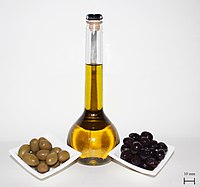
Photo from wikipedia
BACKGROUND Rice bran oil is unique among edible oils due to its rich source of commercially and nutritionally important phytochemicals such as oryzanol. The γ-oryzanol performs an important role on… Click to show full abstract
BACKGROUND Rice bran oil is unique among edible oils due to its rich source of commercially and nutritionally important phytochemicals such as oryzanol. The γ-oryzanol performs an important role on the stability of rice bran oil. The crude rice bran oil obtained by solvent extraction process is subjected to either chemical or physical refining to meet the specifications of edible grade vegetable oil. These refining processes can cause the compounds present in rice bran oil to degrade. The aim of this study was to evaluate the stability of γ-oryzanol present in chemically and physically refined rice bran oils, when submitted at 100 °C, 140 °C and 180 °C for a period of 1368 h. RESULTS The chemically refined rice bran oil presented a lower γ-oryzanol content than the physically refined rice bran oil at all heating temperatures. The losses of γ-oryzanol at the end of the heating periods for the chemically refined oil were 53.47%, 58.48% and 97.05% respectively, and for the physically refined oil were 38.11%, 53.58% and 91.11% respectively. CONCLUSION Based on the results of T50 and T100, it is observed that the oil of rice meal refined physically presents greater stability, in the different temperatures studied and over time than the oil of rice meal refined chemically. Thus, for situations where the oil needs to be subjected to prolonged heating, the temperature of 100 °C is indicated. In this condition the physically refined oil is better for maintaining higher concentration of γ-oryzanol. This article is protected by copyright. All rights reserved.